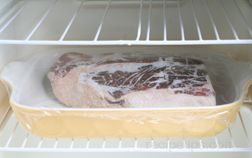Similar Content to: Deep

Not all foods need to be placed in the refrigerator or on the counter for thawing. As an example, foods that will be eaten immediately after thawing, can be warmed in a microwave if placed on the indicated setting for defrosting before being cooked. Similarly, frozen vegetables can be placed in boiling water immediately after being removed from the freezer as a method of thawing. After any food item has been thawed, it is best to prepare it the same day it is thawed, particuarly if it was refrigerated first, and then frozen.
A concern may occur when considering to refreeze an item while it is being thawed. To safely refreeze foods that have been thawing requires a dermination that the temperature of the food being thawed has not reached a temperature below 40º F. If the food has thawed outside of a cold bath or a refrigerator, there is a good chance that the outside layer has warmed above 40º F, so for safety purposes, do not refreeze the food. Always be aware that foods which are refrozen will often lose flavor and generally have some loss of texture, becoming more mushy, and less crisp or less firm in consistency.






